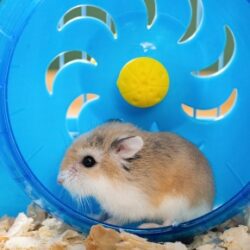Learn how to exercise your small furry pets with Estcourt Vets
Just like with all mammals, keeping your small furry pets exercised is essential for their physical and mental wellbeing. The nurses at Estcourt Vets have put together their advice on how best to exercise your small furry pets.
Our team love seeing your small furry pets thriving – share photos with us on Facebook of how you exercise your small furry pets for the chance of having your pet shared on our page!
Exercise in their enclosure
Whether you have a hamster, gerbil, pet mouse or a fancy rat, most small furries love to play and explore. Check out our Devizes vet nurses’ exercise suggestions below.
- Exercise wheels: A wheel is a must-have for most small furry pets*. Choose an appropriate-sized exercise wheel that allows your pet to run without arching their back and make sure the surface is solid to prevent injuries.
- Climbing structures: Our vet nurses recommend providing climbing opportunities, such as ropes, branches and ladders to help your pet exercise and explore vertical spaces.
- Toys: opt for interactive toys specifically for hamsters, gerbils, mice and rats, and rotate them regularly to avoid boredom. Enrichment toys and tunnels/balls will provide your pet with hours of entertainment.
*It’s important to know that exercise wheels are too dangerous for guinea pigs and should not be used, nor should climbing structures that cannot support their body shapes and weight.
Exercise outside of their enclosure
All small furry pets can become bored which is why it’s essential to vary your hamster, gerbil, guinea pig, rabbit and pet mice and rats’ exercise activities. You can achieve this through time outside of their housing with these aids:
- Playpen: Setting up an external playpen or enclosure where your pet can explore and play outside of their cage. Use tunnels, hideouts, and toys to create an enriching environment.
- Obstacle course: Create a mini obstacle course using cardboard boxes, tunnels, and small toys. Encourage your pet to navigate through the obstacles for mental stimulation and exercise.
- Hide and seek: Our vet nurses advise that your small furries will love this one – hide small treats or pieces of fresh vegetables around your pet’s enclosure. This stimulates their natural foraging instincts and keeps them active and happy.
- Supervised outdoor time: If your pet can safely enjoy outdoor time, consider taking them outside in a secure, escape-proof playpen or harness. Ensure they are protected from predators lurking in and around Devizes and environmental hazards.
- Social interaction: Many small furry pets are social animals (usually except hamsters) and benefit from interacting with their owners. Gently handle and play with your pet to provide mental and physical stimulation.
Remember that small furry pets have varying exercise needs and preferences and it is important to tailor their exercise routine to their species and individual personalities. For personalised advice on your own pet’s exercise requirements, contact Estcourt Vets on 01380 723687.
Share your pet pics on our Facebook page
< Back to articles Estcourt Vets Devizes
Estcourt Vets Devizes